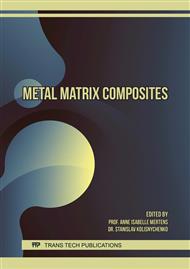p.1880
p.1886
p.1892
p.1898
p.1907
p.1914
p.1920
p.1927
p.1933
Development and Properties of Cast TiAl Matrix In Situ Composites Reinforced with Carbide Particles
Abstract:
The In Situ composites with microstructurally different types of intermetallic matrix such as nearly γ (TiAl) (composite A), multiphase with high amount of lamellar α2(Ti3Al) + γ (TiAl) regions (composite B) and fully lamellar α2 + γ (composite C) were prepared by centrifugal casting and consecutive heat treatments of Ti-44.5Al-8Nb-0.8Mo-3.6C-0.1B, Ti-37Al-7Nb-0.8Mo-5.9C-0.1B and Ti-46.4Al-5Nb-1C-0.2B (at.%) alloys, respectively. The centrifugal casting results in a uniform distribution of coarse primary carbide particles in the as-cast samples. Hot isostatic pressing (HIP) and heat treatments have no effect on the Vickers hardness of the in-situ composite B but lead to a significant softening of the in-situ composites A and C. The in-situ composite C with a coarse-grained fully lamellar matrix shows a higher flow stress at 1000 °C and improved creep resistance at 800 °C compared to those of the in-situ composites A and B.
Info:
Periodical:
Pages:
1907-1913
Citation:
Online since:
December 2018
Keywords:
Price:
Сopyright:
© 2018 Trans Tech Publications Ltd. All Rights Reserved
Share:
Citation:



